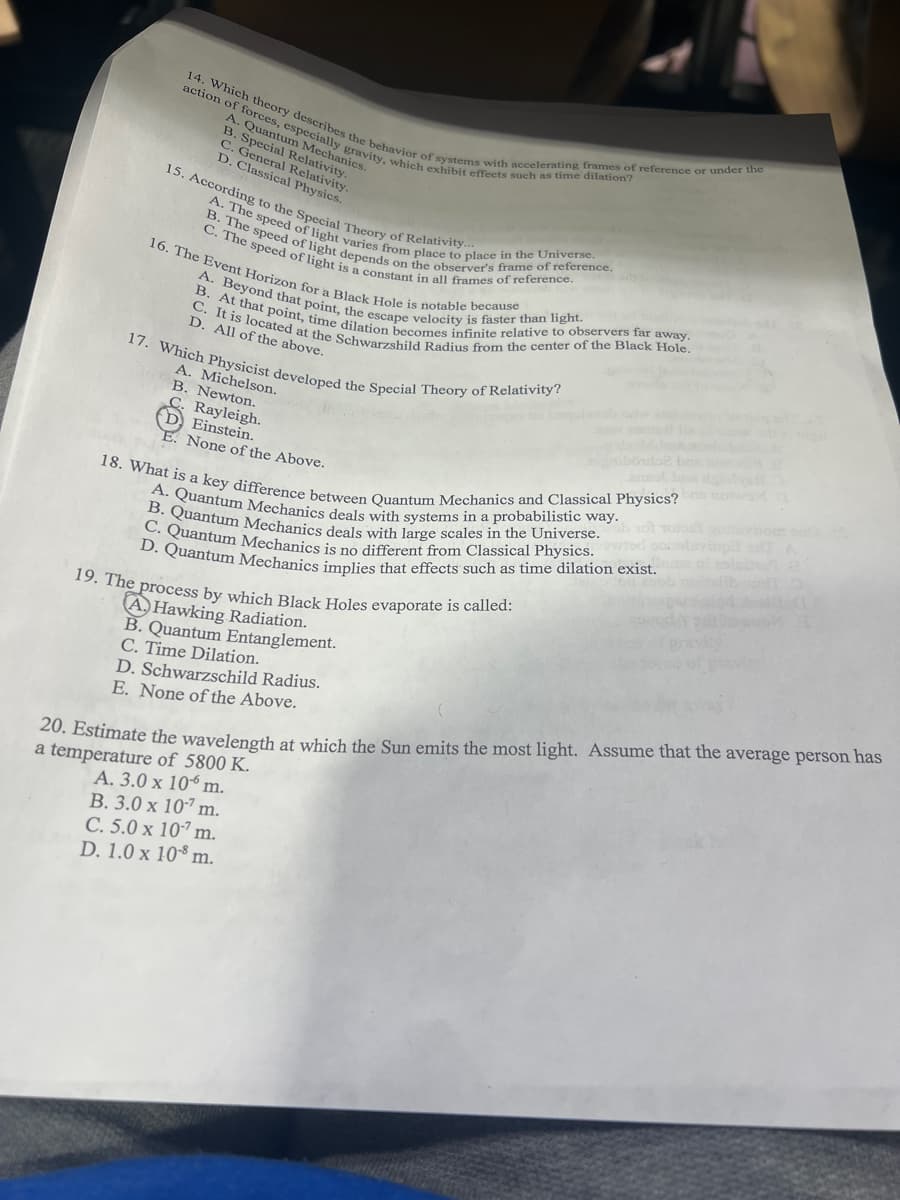Above. 20. Estimate the wavelength at which the Sun emits the most light. Assume that the average person has a temperature of 5800 K. A. 3.0 x 10 m. B. 3.0 x 107 m. C. 5.0 x 107 m. D. 1.0 x 108 m.
Above. 20. Estimate the wavelength at which the Sun emits the most light. Assume that the average person has a temperature of 5800 K. A. 3.0 x 10 m. B. 3.0 x 107 m. C. 5.0 x 107 m. D. 1.0 x 108 m.
Physics for Scientists and Engineers with Modern Physics
10th Edition
ISBN:9781337553292
Author:Raymond A. Serway, John W. Jewett
Publisher:Raymond A. Serway, John W. Jewett
Chapter38: Relativity
Section: Chapter Questions
Problem 43AP
Related questions
Question
Answer question 20 please

Transcribed Image Text:action of forces, especially gravity, which exhibit effects such as time dilation?
14. Which theory describes the behavior of systems with accelerating frames of reference or under the
A. Quantum Mechanics.
B. Special Relativity.
C. General Relativity.
D. Classical Physics.
15. According to the Special Theory of Relativity...
B. The speed of light depends on the observer's frame of reference,
A. The speed of light varies from place to place in the Universe.
16. The Event Horizon for a Black Hole is notable because
C. The speed of light is a constant in all frames of reference.
C. It is located at the Schwarzshild Radius from the center of the Black Hole,
B. At that point, time dilation becomes infinite relative to observers far away.
A. Beyond that point, the escape velocity is faster than light.
D. All of the above.
17. Which Physicist developed the Special Theory of Relativity?
A. Michelson.
B. Newton.
C. Rayleigh.
(D) Einstein.
E. None of the Above.
18. What is a key difference between Quantum Mechanics and Classical Physics? om now.
A. Quantum Mechanics deals with systems in a probabilistic way.
B. Quantum Mechanics deals with large scales in the Universe,ob 101 101olt gottaviom
C. Quantum Mechanics is no different from Classical Physics, wiod soslaviup ed A
D. Quantum Mechanics implies that effects such as time dilation exist.
19. The process by which Black Holes evaporate is called:
A Hawking Radiation.
B. Quantum Entanglement.
C. Time Dilation.
D. Schwarzschild Radius.
E. None of the Above.
ibordo2 bas ist d
20. Estimate the wavelength at which the Sun emits the most light. Assume that the average person has
a temperature of 5800 K.
A. 3.0 x 106 m.
B. 3.0 x 107 m.
C. 5.0 x 107 m.
D. 1.0 x 10 m.
Expert Solution
This question has been solved!
Explore an expertly crafted, step-by-step solution for a thorough understanding of key concepts.
Step by step
Solved in 2 steps

Knowledge Booster
Learn more about
Need a deep-dive on the concept behind this application? Look no further. Learn more about this topic, physics and related others by exploring similar questions and additional content below.Recommended textbooks for you

Physics for Scientists and Engineers with Modern …
Physics
ISBN:
9781337553292
Author:
Raymond A. Serway, John W. Jewett
Publisher:
Cengage Learning

Physics for Scientists and Engineers
Physics
ISBN:
9781337553278
Author:
Raymond A. Serway, John W. Jewett
Publisher:
Cengage Learning

Principles of Physics: A Calculus-Based Text
Physics
ISBN:
9781133104261
Author:
Raymond A. Serway, John W. Jewett
Publisher:
Cengage Learning

Physics for Scientists and Engineers with Modern …
Physics
ISBN:
9781337553292
Author:
Raymond A. Serway, John W. Jewett
Publisher:
Cengage Learning

Physics for Scientists and Engineers
Physics
ISBN:
9781337553278
Author:
Raymond A. Serway, John W. Jewett
Publisher:
Cengage Learning

Principles of Physics: A Calculus-Based Text
Physics
ISBN:
9781133104261
Author:
Raymond A. Serway, John W. Jewett
Publisher:
Cengage Learning

College Physics
Physics
ISBN:
9781285737027
Author:
Raymond A. Serway, Chris Vuille
Publisher:
Cengage Learning

College Physics
Physics
ISBN:
9781305952300
Author:
Raymond A. Serway, Chris Vuille
Publisher:
Cengage Learning

Physics for Scientists and Engineers, Technology …
Physics
ISBN:
9781305116399
Author:
Raymond A. Serway, John W. Jewett
Publisher:
Cengage Learning